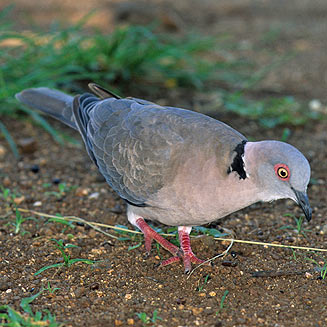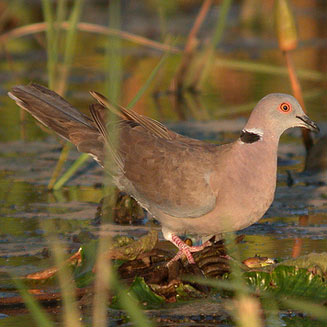|
Streptopelia decipiens (African
mourning Dove)
Rooioogtortelduif [Afrikaans]; Haikonda
(generic term for turtle dove) [Kwangali]; Tuba [Tsonga]; Treurtortel [Dutch];
Tourterelle pleureuse [French]; Angolaturteltaube, Angolalachtaube, Brillentaube
[German]; Rola-gemedora [Portuguese]
Life
> Eukaryotes >
Opisthokonta
> Metazoa (animals) >
Bilateria >
Deuterostomia > Chordata >
Craniata > Vertebrata (vertebrates) > Gnathostomata (jawed
vertebrates) > Teleostomi (teleost fish) > Osteichthyes (bony fish) > Class:
Sarcopterygii (lobe-finned
fish) > Stegocephalia (terrestrial
vertebrates) > Tetrapoda
(four-legged vertebrates) > Reptiliomorpha > Amniota >
Reptilia (reptiles) >
Romeriida > Diapsida > Archosauromorpha > Archosauria >
Dinosauria
(dinosaurs) > Saurischia > Theropoda (bipedal predatory dinosaurs) >
Coelurosauria > Maniraptora > Aves
(birds) > Order: Columbiformes > Family:
Columbidae > Streptopelia
 |
 |
|
African mourning dove, South Africa. [photo H. Robertson, Iziko
©] |
African mourning dove, Botswana. [photo
Tristan Bantock
©] |
The African mourning dove lives in small areas in the
northern
half of southern Africa, where it is locally common. It lives in moist savanna,
cultivated areas and riverine Acacia woodland. Its diet consists mostly
of seeds, with very small amounts of fruit and insects. The female builds a nest of twigs, leaves and roots, the male gathering
the material. It lays 1-2 eggs, which are incubated for 13-14 days (recorded in
captivity). The chicks stay in the nest 15-18 days.
Distribution and habitat
Occurs in sub-Saharan Africa, excluding the lowland forest
of West Africa and the DRC. In southern Africa it is locally common in northern
Namibia, northern Botswana, southern and northern Zimbabwe, Mozambique and
north-eastern South Africa. It generally prefers moist lowland savanna, riverine Acacia woodland and cultivated areas surrounding
villages. It can also be found in patches of Ana-trees (Faidherbia albida) on flood plains of the Zambezi river.
|
 |
|
Distribution of African mourning dove in southern Africa,
based on statistical smoothing of the records from first SA Bird Atlas
Project (©
Animal Demography unit, University of
Cape Town; smoothing by Birgit Erni and Francesca Little). Colours range
from dark blue (most common) through to yellow (least common).
See here for the latest distribution
from the SABAP2. |
Food
Mainly eats seeds,
supplemented with insects and fruit. It typically forages on the ground, in flocks
of up to about 30 birds. The following food items have been recorded
in its diet:
- Plants
- seeds:
- Panicum (grasses)
- Tribulus terrestris (Devil's thorn)
- Giseckia pharnacoides (Volstruisduiwe)
- Maytenus (silky-barks)
- Boscia (shepherds-trees)
- Croton megalobotrys (Fever-berry)
- Ricinus communis (alien Castor oil bush)
- sorghum
- sunflower
- Salvadora persica (Mustard-tree)
- fruit
- Salvadora persica (Mustard-tree)
-
Termite alates
Breeding
- The female builds the nest with material collected by the male, consisting
of a 15 cm wide bowl, made with twigs,
leaves and roots, and typically placed in forks in trees 1.5-15.0 metres above
ground.
- Laying dates are as follows:
| |
Jan |
Feb |
Mar |
Apr |
May |
Jun |
Jul |
Aug |
Sep |
Oct |
Nov |
Dec |
| Botswana |
|
x |
|
x |
|
x |
|
|
|
| Zimbabwe |
|
|
|
|
|
|
|
|
x |
| Mpumalanga and Limpopo province lowveld |
|
|
|
|
|
x |
|
|
|
|
- It lays 1-2 eggs, which are incubated for about 13-14 days (recorded in captivity).
- The chicks stay in the nest for 15-18 days.
Threats
Not threatened.
References
-
Hockey PAR, Dean WRJ and Ryan PG 2005. Roberts
- Birds of southern Africa, VIIth ed. The Trustees of the John Voelcker
Bird Book Fund, Cape Town.
|
